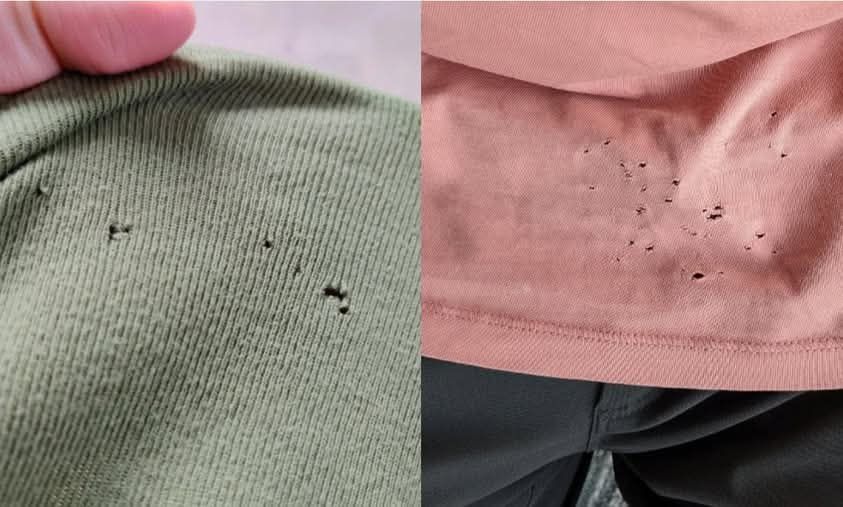ADVERTISEMENT
**Solution**: Always make sure to zip zippers and fasten Velcro straps before putting clothes in the washing machine. It’s also important to separate delicate items from those with zippers or abrasive materials. Additionally, avoid overloading the washing machine to ensure that clothes have enough space to move freely without unnecessary friction.
—
### **4. Pilling and Snags: How They Contribute to Holes**
Pilling and snags often happen when a fabric rubs against rough surfaces or other materials. While pilling itself doesn’t directly cause holes, it’s a sign of fabric wear, and it can eventually contribute to the development of tiny holes in your T-shirt.
#### **Pilling**
Pilling occurs when the fibers in your T-shirt become tangled or knotted together, creating small balls of fabric. Pilling is more common in synthetic fibers and lower-quality cotton fabrics. These tiny balls of fabric can eventually cause the fibers to weaken, which increases the chances of holes appearing.
#### **Snags**
A snag happens when the fibers of the fabric get caught on a rough surface, like a piece of jewelry, furniture, or even a stray nail. Once a snag occurs, it can unravel the fibers, making them weaker and more susceptible to breaking, which results in tiny holes over time.
**Solution**: Use a fabric shaver to remove pills and keep the fabric smooth. Be cautious around rough surfaces when wearing your T-shirt, and avoid wearing jewelry or accessories that could cause snags.
—
### **5. Body Oils and Sweat**
Another overlooked cause of tiny holes in T-shirts is the accumulation of **body oils** and **sweat**. These substances can break down the fabric over time, weakening the fibers and causing tiny holes to form.
#### **Sweat and Body Oils**
Our skin naturally secretes oils, and when we sweat, it can cause fabric to become saturated with moisture. This creates a breeding ground for bacteria, which can break down the fibers in the fabric. Areas that are prone to the most sweating—such as under the arms, around the collar, and near the waist—are particularly vulnerable to fabric wear. Over time, the fibers begin to weaken, and tiny holes appear.
**Solution**: To reduce the impact of body oils and sweat on your T-shirts, make sure to wash them regularly, especially after wearing them during exercise or in hot weather. Using a gentle detergent and avoiding fabric softeners can help preserve the integrity of the fabric.
—
### **6. Improper Drying**
How you dry your clothes plays a crucial role in extending the life of your T-shirts. High heat can weaken fibers, causing them to become brittle and more prone to breaking.
#### **Heat Damage from Dryers**
Using high heat settings on your dryer can shrink fabrics, weaken fibers, and ultimately lead to the formation of tiny holes. This is particularly true for delicate fabrics like cotton and synthetic blends, which are prone to damage when exposed to excessive heat.
**Solution**: To avoid heat damage, always check the care label on your T-shirt before drying it. Opt for a lower heat setting, or better yet, air dry your T-shirt by hanging it up or laying it flat to dry.
—
### **Conclusion: How to Prevent Tiny Holes in T-Shirts**
Tiny holes in T-shirts are a common but frustrating problem, and there are several reasons why they appear. From friction caused by seat belts or bags to poor fabric quality and laundry mishaps, these holes can develop over time if you’re not careful. However, by understanding the causes of these tiny holes, you can take simple steps to prevent them from happening.
By investing in high-quality fabrics, using proper laundry techniques, and being mindful of daily wear and tear, you can extend the life of your T-shirts and keep them looking new for longer. Whether it’s avoiding overloading the washing machine, using the right drying techniques, or paying attention to the fabrics you wear, these small changes can make a significant difference in preserving the integrity of your favorite T-shirts.
So, next time you notice a tiny hole appearing in your T-shirt, you’ll know exactly what’s causing it—and more importantly, how to stop it from happening again!
